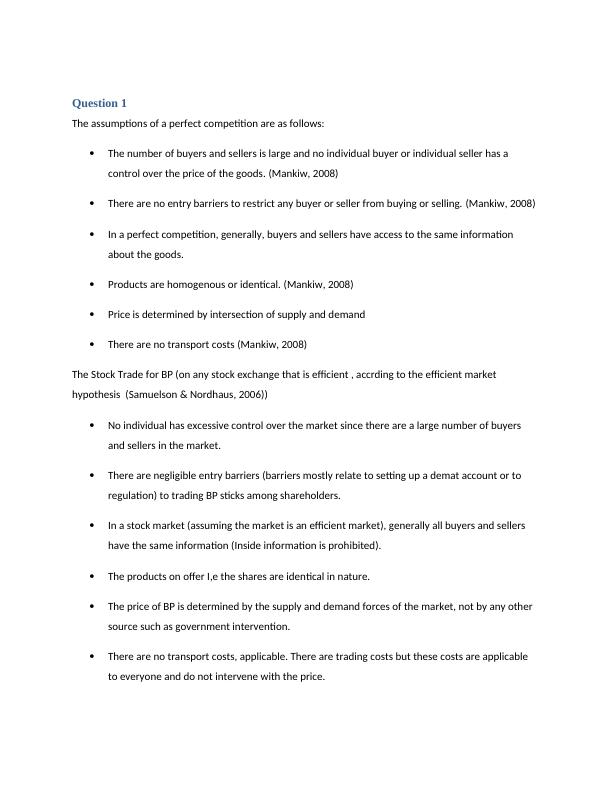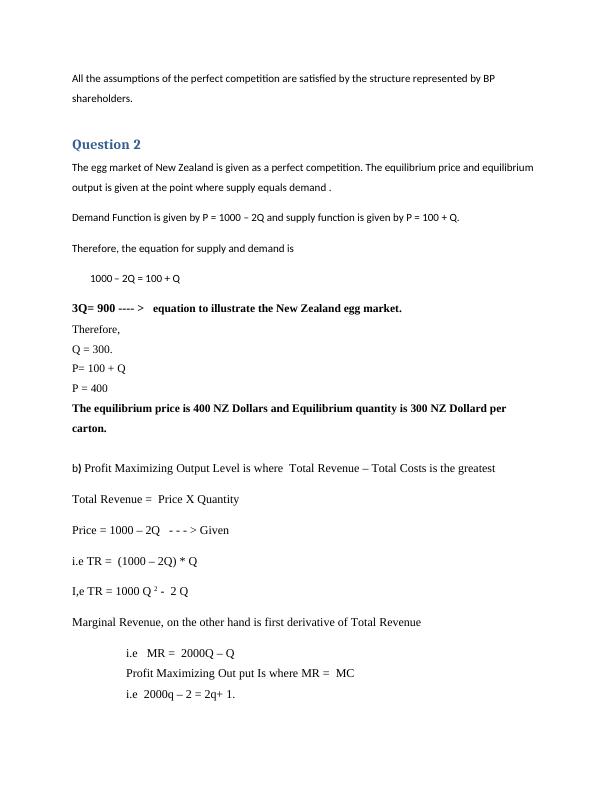The Assumptions of a Perfect Competition
Added on 2020-04-15
15 Pages2920 Words147 Views
Question 1The assumptions of a perfect competition are as follows:The number of buyers and sellers is large and no individual buyer or individual seller has a control over the price of the goods. (Mankiw, 2008)There are no entry barriers to restrict any buyer or seller from buying or selling. (Mankiw, 2008)In a perfect competition, generally, buyers and sellers have access to the same information about the goods.Products are homogenous or identical. (Mankiw, 2008)Price is determined by intersection of supply and demandThere are no transport costs (Mankiw, 2008)The Stock Trade for BP (on any stock exchange that is efficient , accrding to the efficient market hypothesis (Samuelson & Nordhaus, 2006))No individual has excessive control over the market since there are a large number of buyers and sellers in the market.There are negligible entry barriers (barriers mostly relate to setting up a demat account or to regulation) to trading BP sticks among shareholders.In a stock market (assuming the market is an efficient market), generally all buyers and sellers have the same information (Inside information is prohibited).The products on offer I,e the shares are identical in nature.The price of BP is determined by the supply and demand forces of the market, not by any other source such as government intervention.There are no transport costs, applicable. There are trading costs but these costs are applicable to everyone and do not intervene with the price.

All the assumptions of the perfect competition are satisfied by the structure represented by BP shareholders.Question 2The egg market of New Zealand is given as a perfect competition. The equilibrium price and equilibrium output is given at the point where supply equals demand .Demand Function is given by P = 1000 – 2Q and supply function is given by P = 100 + Q.Therefore, the equation for supply and demand is1000–2Q = 100 + Q3Q= 900 ---- > equation to illustrate the New Zealand egg market. Therefore,Q = 300.P= 100 + QP = 400The equilibrium price is 400 NZ Dollars and Equilibrium quantity is 300 NZ Dollard per carton.b) Profit Maximizing Output Level is where Total Revenue – Total Costs is the greatestTotal Revenue = Price X QuantityPrice = 1000 – 2Q - - - > Giveni.e TR = (1000 – 2Q) * QI,e TR = 1000 Q 2 - 2 QMarginal Revenue, on the other hand is first derivative of Total Revenuei.e MR = 2000Q – QProfit Maximizing Out put Is where MR = MCi.e 2000q – 2 = 2q+ 1.

Q = 666Total Revenue = 1000Q 2 - 2 Q4443222= 443556000 – 2 * 666= 443554668Total Cost = 100 + Q2 + Q = 100 + 443556 +666= 4443222Total Profit = 439111446d) This is the short run equilibrium because the second derivative of the production function is 2.In the long run, the firm will only produce where the second derivate of the supply curve is zero.e) The long run equilibrium will be where average cost curve will be equal to marginal cost curve and the marginal revenue, in a perfect competition.Hence, the average total cost will be equal to the Marginal Cost (100+q2+q)/q = 2q +1I.e. 100 + q2+q = 2q2 + qi.e. 100 = q2Therefore, q = 10.Thus, 10 boxes or will be produced. P= 1000- QI,e P = 980.Thus, P= 980 NZ Dollar per Box and equilibrium output is 10 boxes.

Question 3a)In the long run, zero profits occur because average costs are equal to marginal costs. All factors can be changed in this period . Hence, all costs are variable costs. Equilibrium is achieved at the point where the price cuts the minimum point on the Long Run Average Cost (LAC) Curve as well as the Marginal Cost Curve. (Mankiw,2008)At this point, the equilibrium of all firms is set at at ‘normal profits’ .This is shown in the diagram below.

End of preview
Want to access all the pages? Upload your documents or become a member.
Related Documents
Economics for Decision Making: Assignmentlg...
|10
|1537
|31
Answers to a question of "The stock market can be very volatile"lg...
|20
|4135
|59
Economics Assignment (Sample)lg...
|16
|2175
|25
Health Care Economicslg...
|6
|564
|90
Economic Analysis - Assignment Samplelg...
|16
|2549
|123
Economics Assignment: Monopoly Market Analysislg...
|12
|1294
|481
